Dog Nail Trim Guide: Easy Tips, Tools & Safety
Ever tried to trim your dog's nails and ended up with a trembling pup? You’re not alone. Nail trimming can feel scary, but with the right approach it’s a quick, painless part of grooming. Below you’ll get the practical steps, the gear you really need, and the warning signs that tell you when to stop.
What You Need Before You Start
First, pick a clipper that fits your dog’s size. Small‑to‑medium clips work for most breeds, while a grinder is better for thick nails or older dogs. Have some styptic powder or a cotton ball with a dab of cornstarch handy – it stops bleeding fast if you nick the quick. A treat pouch is a must; rewarding your dog right after each nail keeps the experience positive.
Step‑by‑Step Trimming Process
1. Pick a calm spot. Sit on the floor or a low chair so you’re at eye level. A quiet room with soft lighting helps your dog relax.
2. Handle the paws. Gently press the toe to expose the nail. If your dog is nervous, start with just one paw and give a treat before moving on.
3. Identify the quick. In light‑colored nails you’ll see a pink line. In dark nails look for a small, lighter spot near the tip. Only cut a little bit at a time – you can always trim more later.
4. Clip at an angle. Hold the clipper like scissors, cut the tip off at a slight angle to avoid a sharp edge. Snap off the nail and give a treat immediately.
5. Check for bleeding. If you see a drop of blood, press the styptic powder or cornstarch until it stops. Stay calm; the nail will clot quickly.
6. Repeat for each paw. Most dogs need only a few seconds per nail. If your pup starts to stress, pause, offer a longer break, or finish the next day.
When you’re done, brush the paws with a soft brush to remove any tiny nail fragments. A quick massage after trimming reinforces the positive vibe.
**How Often Should You Trim? A good rule is to check nails every 1‑2 weeks. If you hear a click on the floor when your dog walks, it’s time to trim. Overgrown nails can cause discomfort, altered gait, and even joint problems.
**Common Mistakes to Avoid**
- Skipping the quick: always trim a little, not a lot.
- Using human nail clippers: they’re too small and can crush the nail.
- Rushing the job: a calm pace keeps your dog steady and reduces the chance of cuts.
**When to Call a Professional**
If your dog is extremely anxious, has thick nails that won’t budge, or you’ve accidentally cut the quick multiple times, a groomer or vet can finish the job safely. It’s better to pay a little extra than to risk injury.
Trimming your dog’s nails doesn’t have to be a nightmare. With the right tools, a gentle approach, and plenty of treats, you’ll turn a dreaded chore into a quick, low‑stress routine. Try these steps tonight and see how quickly your pup gets used to the routine – your floors (and your dog’s paws) will thank you.

Do You Tip for Dog Nail Trim? Here's What You Should Know
Navigating the etiquette of tipping for dog nail trimming can be confusing. While tipping is often customary for personal services, it's not always clear if this applies to pet grooming. This article explores whether you should tip those who groom your furry friend. It covers the practices in the dog grooming industry and provides useful tips on how much to tip if you decide to do so.
View more